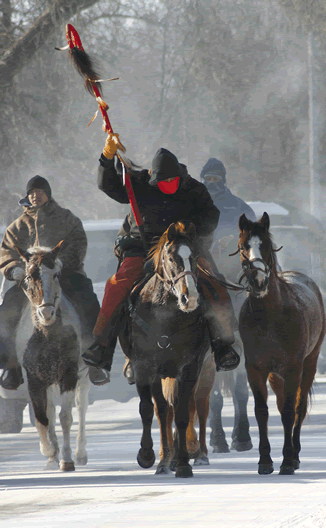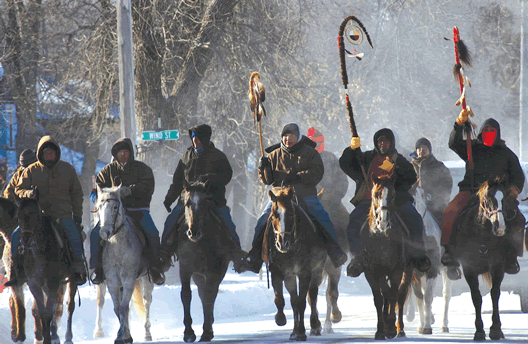 |
Canku Ota
|
 |
|
(Many Paths)
|
||
|
An Online Newsletter
Celebrating Native America
|
||
|
January 1, 2009 - Volume
7 Number 1
|
||
|
|
||
|
Dakota 38 riders
Gallop Through Flandreau
|
||
|
from The Moody County
Enterprise, Flandreau, South Dakota
|
||
|
credits: {credits}
|
|
Ride commemorates Mankato hangings, began with one man’s dream It started with a dream.
“Indians have signs, visions and dreams,” Miller said, “and these are the three things that move us. Once you have a dream, your people get behind you to help fulfill it. In our world it takes four years to do it, and then you get on with your life.” But what Miller didn’t know was the impact his dream would have on all of the descendants of the Dakota Sioux Tribe. Miller, who lives on the Pine Ridge Indian Reservation in Porcupine, S.D., had his dream in 2005. In the dream, he traveled 330 miles on horseback, eventually coming to a riverbank in Minnesota where he saw 38 of his own ancestors hanged. Miller then realized that he had dreamed of an event that took place in 1862. It was the Dakota Sioux Uprising, which ended in the largest mass execution ever recorded in U.S. history. On Dec. 26, 1862, 38 Dakota men were hanged in what is now Mankato, Minn. Also, a federal policy and a newly formed state resulted in the removal of Dakota people from their lands, scattering them from Saskatchewan to Nebraska. Miller stepped forward with his vision in December of 2005, and riders from several tribes rode over from the Lower Sioux Indian Community near Morton, Minn., to the site of the execution in Mankato. The purpose of the ride was to commemorate the men, women and children who were forced to march across the cold winter prairies to the hanging at a large concentration camp at Fort Snelling, Minn. The event became known as the Dakota 38 Reconciliation Ride. Because this is the final year of Miller’s vision, the riders are in it for the long haul, a 330–mile trip from the Lower Brule Indian Reservation in central South Dakota to Mankato that will complete the trip just as Miller envisioned it. Riders range in age from 6 years old to 60.
“The power from our ancestors (is) with us,” Miller said. “You don’t feel the cold. Oh man, it’s so powerful I can’t put it in words. So much that it makes you cry. When riding, many of the young are crying because they can feel the power.” Miller said more than 100 of the horse-backers will meet at the final destination in Mankato. Following those on the ride are eight horse trailers, portable toilets, hay trailers and a flatbed with supplies. Miller said participants sleep either in the vehicles or spaces provided by landowners they camp with. He added that the riders were able to camp in tipis on two different occasions, which was a good sign to him. The riders are even turning their trip into a documentary, which Miller hopes will be used for educational purposes some day. The ride costs nearly $70,000 for supplies for the riders and horses, and is entirely funded through donations. Miller says he’s always surprised by the generosity of the people he meets along the way. He feels as though he was meant to head up the ride, like it was his obligation all along. He says there were signs in the dream that led him to this conclusion. “At one point in the dream, we got in a circle and prayed to all four directions, and there was a staff with 38 eagle feathers on it,” Miller said. “It was the only time I have ever seen anything like it.” But making the trip is about more than just fulfilling the dream for Miller and his fellow riders. “We
are doing this so our kids don’t lose their culture and their
customs,” he said. “We will keep going, not only to honor
the dream, but to show that our people were marched first, out of
Minnesota in the wintertime. It’s been a humbling experience
for me.” In addition to preserving culture, Miller explains that the rituals at the end of the ride are about forgiveness and forgiving.
“The
negativity then goes to that horse,” he said. “It creates
brotherhood and unity, linking a new relationship with white people.
It shows we are the first ones to forgive, to apologize. We want
to be forgiven too, to be able to live out our lives in harmony.” Miller says that each time he and the riders have gathered around the buffalo, they’ve spotted an eagle soaring nearby. According to Miller, medicine men in American Indian culture say the eagles are releasing or taking spirits back to where they belong. “We believe in spirits the Bible doesn’t,” Miller said. “We have our own traditional culture, and every stop on the trip tells the story. This is Minnesota’s darkest secret, and the state’s 150th anniversary is this year. Only the creator could give me a dream that would coincide with that and the last year of its fulfillment.” Though
this is the last year Miller is participating in his “dream
ride,” he said the young people involved want to keep the event
alive. He hopes to help coordinate it in the future. What the riders will lack in the ensuing years is the spirit Miller brought to the participants. He isn’t afraid to tell his comrades that he cares for them. “I make sure everyday to tell them,” he said, “I say, ‘I love you guys.’” Donations for the Dakota 38 Reconciliation Ride can be sent to Dakota Wichohan, P.O. Box 7, Granite Falls, Minn., 56241. For more information, find it on the web at www.dakota38.com. |
|
insert map here
|
www.expedia.com |
|
|
||
|
|
||
| Canku Ota is a free Newsletter celebrating Native America, its traditions and accomplishments . We do not provide subscriber or visitor names to anyone. Some articles presented in Canku Ota may contain copyright material. We have received appropriate permissions for republishing any articles. Material appearing here is distributed without profit or monetary gain to those who have expressed an interest. This is in accordance with Title 17 U.S.C. Section 107. | ||
|
Canku Ota is a copyright ©
2000, 2001, 2002, 2003, 2004, 2005, 2006, 2007, 2008, 2009 of Vicki
Barry and Paul Barry.
|
||
 |
 |
|
|
The "Canku
Ota - A Newsletter Celebrating Native America" web site and
its design is the
|
||
|
Copyright ©
1999, 2000, 2001, 2002, 2003, 2004, 2005,
2006, 2007, 2008 of Paul C.
Barry.
|
||
|
All Rights Reserved.
|
||
 Jim
Miller, a 60–year–old Vietnam veteran, Lakota Spiritual
Leader and a descendant of the Dakota Sioux Tribe, said he dreamt
of himself on a horse, traveling east. He was accompanied by a number
of other riders, though he didn’t know where he was going or
why.
Jim
Miller, a 60–year–old Vietnam veteran, Lakota Spiritual
Leader and a descendant of the Dakota Sioux Tribe, said he dreamt
of himself on a horse, traveling east. He was accompanied by a number
of other riders, though he didn’t know where he was going or
why.  More
than 60 of the participating riders came through Flandreau Dec.
15 and camped for the night on Santee Sioux tribal ground. Though
temperatures read well below the zero mark, participants were unfazed.
More
than 60 of the participating riders came through Flandreau Dec.
15 and camped for the night on Santee Sioux tribal ground. Though
temperatures read well below the zero mark, participants were unfazed. In
the final stretch through Mankato, the riders gather around a buffalo
monument, where they pray for their ancestors. A rider-less horse
carries four offerings of sacred food, which Miller said is meant
to discourage negativity.
In
the final stretch through Mankato, the riders gather around a buffalo
monument, where they pray for their ancestors. A rider-less horse
carries four offerings of sacred food, which Miller said is meant
to discourage negativity.